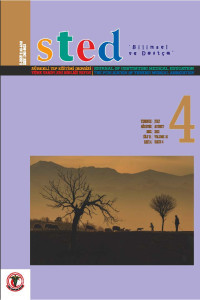Babaların Uyguladığı Kanguru Bakımının Etkileri: Sistematik Derleme
Kangaroo father care, Paternal kangaroo care, Bebek
The Effects of Kangaroo Care Applied by Fathers: A Systematic Review
Kangaroo father care, Paternal kangaroo care, Infant,
___
- Referans1. World Health Organization. Kangaroo mother care: A practical guide. Department of Reproductive Health and Research. 2003. WHO, Geneva, Switzerland, 1–48. http://apps.who.int/iris/bitstream/10665/42587/1/9241590351.pdf.
- Referans2. Cong X, Ludington-Hoe SM, Hussain N, Cusson RM, Walsh S, Vazquez V ve ark. Parental oxytocin responses during skin-to-skin contact in pre-term infants. Early Human Development 2015; 91(7): 401-406.
- Referans3. Sarparast L, Farhadi R, Sarparast M, Shafai S. The effect of kangaroo mother care on neonatal outcomes in Iranian hospitals: A review. Journal of Pediatrics Review 2015; 3(1): e195.
- Referans4. UNICEF, U. Guide to the baby friendly initiative standards. 2012. UNICEF: London.
- Referans5. Baley J. Skin-to-skin care for term and preterm infants in the neonatal ICU. Pediatrics 2015; 136(3): 596-599.
- Referans6. Çavuşoğlu H. Yüksek riskli yenidoğan ve hemşirelik bakımı. H. Çavuşoğlu (Ed.). Çocuk Sağlığı Hemşireliği (Genişletilmiş 10. Baskı, Cilt 2) (s.57-116). 2013. Ankara: Sistem Ofset Basımevi.
- Referans7. Srinath BK, Shah J, Kumar P, Shah PS. Kangaroo care by fathers and mothers: comparison of physiological and stress responses in preterm infants. Journal of Perinatology 2016; 36(5): 401.
- Referans8. Blomqvist YT, Rubertsson C, Kylberg E, Jöreskog K, Nyqvist KH. Kangaroo Mother Care helps fathers of preterm infants gain confidence in the paternal role. Journal of advanced nursing 2012; 68(9): 1988-1996.
- Referans9. Rulo A. Kangaroo Care. JCCC Honors Journal 2013; 4(1): 6.
- Referans10. Mörelius E, Örtenstrand A, Theodorsson E, Frostell A. A randomised trial of continuous skin-to-skin contact after preterm birth and the effects on salivary cortisol, parental stress, depression, and breastfeeding. Early human development 2015; 91(1): 63-70.
- Referans11. Seidman G, Unnikrishnan S, Kenny E, Myslinski S, Cairns-Smith S, Mulligan B ve ark. Barriers and enablers of kangaroo mother care practice: a systematic review. PloS one 2015; 10(5): e0125643.
- Referans12. Conde‐Agudelo A, Belizán JM, Diaz‐Rossello J. Cochrane review: kangaroo mother care to reduce morbidity and mortality in low birthweight infants. Evidence‐Based Child Health: A Cochrane Review Journal 2012; 7(2): 760-876.
- Referans13. Krishnan L. Pain relief in neonates. journal of neonatal surgery 2013; 2(2): 19.
- Referans14. Bauer J, Sontheimer D, Fischer C, Linderkamp O. Metabolic rate and energy balance in very low birth weight infants during kangaroo holding by their mothers and fathers. The Journal of paediatrics 1996; 129(4): 608-611.
- Referans15. Shah V, Jefferies A. Preterm infants receiving heel lance procedures have slightly lower pain scores and quicker time to return to baseline heart rate when held in kangaroo care by the mother than by the father. BMJ evidence-based medicine 2012, ebmed-2012.
- Referans16. Johnston, C. C., Campbell-Yeo, M., & Filion, F. (2011). Paternal vs maternal kangaroo care for procedural pain in preterm neonates: a randomized crossover trial. Archives of pediatrics & adolescent medicine, 165(9), 792-796.
- Referans17. Srinath BK, Shah J, Kumar P, Shah PS. Kangaroo care by fathers and mothers: comparison of physiological and stress responses in preterm infants. Journal of perinatology 2015; 1-4.
- Referans18. Velandia M, Uvnäs‐Moberg K, Nissen E. Sex differences in newborn interaction with mother or father during skin‐to‐skin contact after Caesarean section. Acta Paediatrica 2012; 101(4): 360-367.
- ISSN: 1300-0853
- Yayın Aralığı: Yılda 6 Sayı
- Başlangıç: 2015
- Yayıncı: Türkiye Tabipleri Birliği
Doç.Dr. Süha Yağcıoğlu’nun Yaşamı ve Özgün Mesleki Yaklaşımı Üzerine Bir Araştırma
Babaların Uyguladığı Kanguru Bakımının Etkileri: Sistematik Derleme
Elektronik Fetal Monitorizasyon Sonucunun Apgar Skor Sistemi Değeriyle Karşılaştırılması
Gülbahtiyar DEMİREL, Gülseren DAĞLAR, Dilek BİLGİÇ
Kötü Haber Verme Becerisi Eğitiminin SPIKES Yaklaşımı Işığında Değerlendirilmesi
Önder İLGİLİ, Arif ONAN, Orhan ODABAŞI
Okul çantası ergonomisi ve sağlık
Cavit İşık YAVUZ, Çağatay GÜLER
Yoğun Bakım Hastalarında Antibiyotiklerin Diğer İlaçlarla Etkileşimlerinin Değerlendirilmesi
Emre KARA, Kamer TECEN-YÜCEL, Nesligül ÖZDEMİR, Ahmet Çağkan İNKAYA, Aygin BAYRAKTAR-EKİNCİOĞLU, Kutay DEMİRKAN, Serhat ÜNAL
Aylin BAYINDIR GÜMÜŞ, Hülya YARDIMCI
FRAS1 Gen Mutasyonuna Sahip Fraser Sendromlu Yenidoğan Olgu
Zübeyde DİNÇER, Hatice GÜNEŞ, Nurgül ÇİMEN PARLAK, Salim EKİCİ, Sevcan İPEK, Sadık YURTTUTAN
